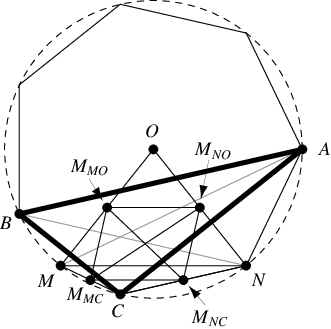The regular heptagon is the seven-sided regular polygon illustrated above, which has Schläfli symbol . According to Bankoff and Garfunkel
(1973), "since the earliest days of recorded mathematics, the regular heptagon
has been virtually relegated to limbo." Nevertheless, Thébault (1913)
discovered many beautiful properties of the heptagon, some of which are discussed
by Bankoff and Garfunkel (1973).
Although the regular heptagon is not a constructible polygon using the classical rules of Greek geometric
construction, it is constructible using a Neusis
construction (Johnson 1975; left figure above). To implement the construction,
place a mark
on a ruler
,
and then build a square of side length
. Then construct the perpendicular bisector at
to
, and draw an arc centered at
of radius
. Now place the marked ruler so that it passes through
,
lies on the arc, and
falls on the perpendicular bisector. Then
, and two such triangles give the vertex
angle
of a regular heptagon. Conway and Guy (1996) give a Neusis
construction for the heptagon. In addition, the regular heptagon can be constructed
using seven identical toothpicks to form 1:3:3 triangles (Finlay 1959, Johnson 1975,
Wells 1991; right figure above). Bankoff and Garfunkel (1973) discuss the heptagon,
including a purported discovery of the Neusis
construction by Archimedes (Heath 1931). Madachy (1979) illustrates how to construct
a heptagon by folding and knotting a strip of paper, and the regular heptagon can
also be constructed using a conchoid of Nicomedes.
Although the regular heptagon is not constructible using classical techniques, Dixon (1991) gives constructions for several angles very
close to .
While the angle subtended by a side is
, Dixon gives constructions
containing angles of
,
,
and
.
In the regular heptagon with unit circumradius and center ,
construct the midpoint
of
and the mid-arc point
of the arc
, and let
be the midpoint of
. Then
(Bankoff and Garfunkel 1973).
In the regular heptagon, construct the points ,
, and
as above. Also construct the midpoint
and construct
along the extension of
such that
. Note that the apothem
of the heptagon has length
. Then
1. The length
is equal to
,
and also to the largest root of
|
(1)
|
2. ,
and
3.
is tangent to the circumcircle of
(Bankoff and Garfunkel 1973).

Construct a heptagonal triangle in a regular heptagon with center
, and let
and
bisect
and
, respectively, with
and
both lying on the circumcircle. Also define the midpoints
,
,
, and
. Then
|
(2)
| |||
|
(3)
| |||
|
(4)
| |||
|
(5)
|
(Bankoff and Garfunkel 1973).